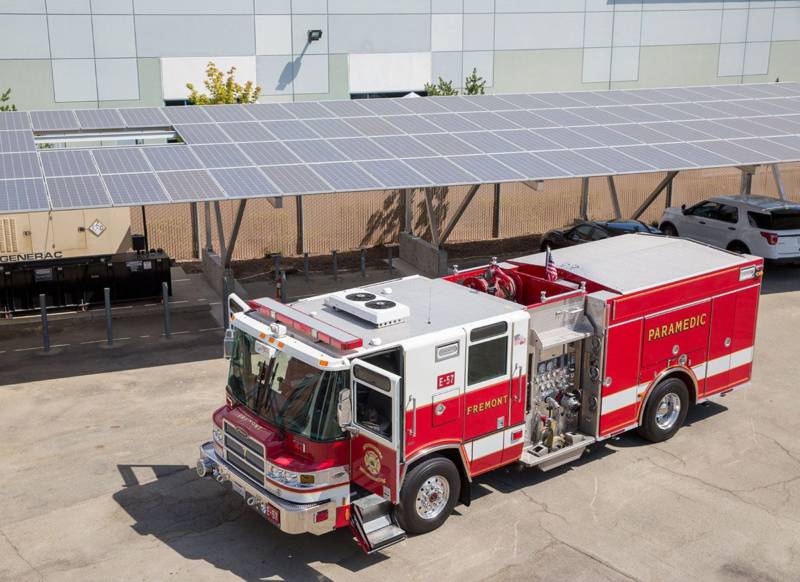Local officials and first responders were stressed about the potential impacts. But one key aspect of public safety they could scratch off their list of anxieties: three Fremont fire stations outfitted with a sophisticated power system designed to keep running when the grid goes down.
“There, we don’t have anything to worry about,” DiFranco said.
That’s because Fremont is one of the first cities in the U.S. to install a microgrid, a small, self-contained electrical system, around a fire station. Fremont’s microgrid includes solar panels, batteries and a generator. Control software allows the stations to operate independently from PG&E’s grid.
“The controller cuts over and pulls that power from the solar and battery,” DiFranco said.
In recent years, PG&E invested billions of dollars to inspect its lines, build weather stations to monitor fire conditions, and take other measures to protect it from liability in connection with sparking another fire.
But the shutoffs that disrupted life throughout the Bay Area this week underscored, once again, that PG&E’s grid technology is old and lacks flexibility.
It didn’t take long for lawmakers to jump on PG&E. They accused the investor-owned utility of applying a jackhammer approach to a precision problem. The outages renewed questions about why the company did not include resilient grid technology like Fremont’s in its wildfire mitigation plan.
San Francisco State Sen. Scott Wiener said in an interview with KPIX 5 that the shutdowns need to be as focused as possible. State Sen. Jerry Hill sent a letter to regulators on Wednesday pushing them to review the shutoffs and regulate them more aggressively in the future.
Sumeet Singh, the executive in charge of PG&E’s wildfire response, explained in a press conference that the utility cut power as a “last resort” to ensure the safety of its customers.
Singh said that one reason the shutoffs were impacting so many people is that regulators expanded guidelines for power shutoffs to include high-voltage lines. The utility complied, affecting many more customers than otherwise would have occurred.
The California Public Utility Commission is examining how projects like the one in Fremont can help shore up the system and make power shutoffs less disruptive.
Currently, similar projects are at the Santa Rita jail in Alameda County and a Kaiser hospital in Richmond.
At least one Bay Area microgrid deployed during the outages last week. Stone Edge Farm, an organic farm and vineyard, is located in an area of Sonoma affected by the shutdowns. The farm’s solar and battery system kept power to three households, a woodworking shop, two car storage barns, trailers, a spa, and a refrigeration van that stored food for local restaurants, according to an email on Friday afternoon from the farm.
In 2018, California lawmakers passed SB 1339, which required the California Public Utilities Commission to support the commercialization of more systems by Dec. 1, 2020. Last month, the power regulator opened a proceeding to coordinate microgrids in high fire-risk areas.
Renewable energy advocates say that the outages should refocus PG&E on newer technologies.
“We are going to see more microgrids as part of the overall strategy,” Michael Colvin, director of the Environmental Defense Fund’s California Energy program said. “The shutoffs will drive these investments.”
San Diego Gas and Electric operates a microgrid at Borrego Springs, and the utility has submitted a plan to regulators to build more throughout San Diego.
Newsom praised the company, calling it “arguably one of the nation’s most effective and efficient” investor-owned utilities. For years, SDG&E has been turning off power lines when the wildfire risk is high.
Fremont’s $2.4 million project was developed by Gridscape Solutions, a renewable-energy-project developer based in the city itself. The California Energy Commission chipped in $1.8 million.
Because the solar panels and batteries offer a consistent source of power, the city estimates that the system will save $250,000 in power costs over a 10-year period, and that it will reduce its greenhouse gas emissions by 80,000 pounds each year.
Personal Systems
A few weeks ago, when Derek Krause, a retired firefighter, was at home in the Oakland foothills, he looked out the window and saw that the rest of the neighborhood, unlike in his house, was black.
The grid was down, Krause, realized. But a battery pack and solar panels he’d installed were keeping his lights on. Most of the time, his system is dormant, quietly feeding power back to PG&E’s grid, and giving Krause a break on his electricity bill.
Along with exploring commercial microgrids, commission officials expanded incentives for residential solar and battery systems like the one Krause owns. This includes $100 million for fire-prone districts, the money designated for low-income households and homes with people with chronic medical conditions.
Elon Musk, CEO of automaker Tesla, and Lynn Jurich, CEO of Sunrun, a solar energy company, were quick to promote their products as a consumer solution for the recent power outages on social media.

